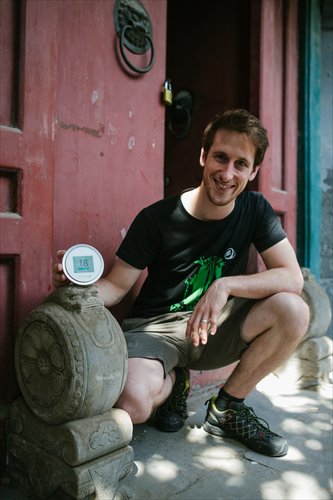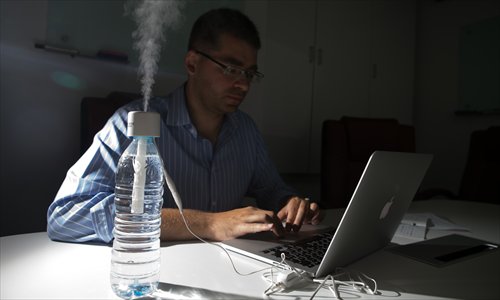Foreign makers on the rise
Expat inventors take the gap in the Chinese market

Liam Bates presents his air quality testing device called Laser Egg. Photo: Li Hao/GT
Liam Bates, 32, moved to Beijing 10 years ago from Switzerland. It was gut-wrenching for him to see his Canadian girlfriend suffering from an asthma attack because of the polluted air in the city, so he decided to make his own air purifier to make their life easier.
"My girlfriend would not stop coughing as soon as she got off the plane. She couldn't even sleep at night," Bates said. His girlfriend's parents suggested they buy an air purifier.
"We went shopping together, but only found a brand I hadn't heard of, the effect was unclear and it cost more than 8,000 yuan ($1,248). The choice was so limited, so I decided to look into it and make one myself."
Bates created his own air purifier called Oxybox. It only took him seven months to come up with his creation at half the cost of branded ones. He also designed an air quality testing device called Laser Egg, which is quite popular among the expat community in China.
There is an official term for people like Bates, who make their own gadgets based on their innovative ideas and combine them with advanced technology to change the way people live - "Maker."
At the 2015 International Maker Week hosted in Shenzhen, Guangdong Province, this June, 260,000 makers from around the world participated in the event, according to a Shenzhen Business News report.
As more foreigners come to live and work in China, more of them are joining the booming market of makers in China - inventing their own gadgets using high technology and even starting their own businesses based on their inventions.

Jonathan Aknin at his desk enjoying the fresh air, thanks to his own invention - a combination of an air purifier and a humidifier. Photo: Li Hao/GT
Foreigners take the gap
Grant Hu, 36, arrived in Beijing from Canada in 2007, and he developed a smart cooking machine called Nise, which will allow foodies to transform their food into Michelin quality with the press of a button.
When Hu first arrived in China, he realized the fast pace of life doesn't allow working-class people like him to cook very often, so they have to order in or go to little restaurants to eat, which can be unsanitary.
"I constantly read news about how restaurants used gutter oil and meat that's been stored for months. The news freaked me out," Hu said.
"I think there are a lot of foodies in China like me, who always crave cuisine from famous chefs. I flew to Hong Kong last July just to have dinner cooked by my favorite Michelin chef."
The smart food machine Hu developed can produce over 1,000 dishes - both Chinese and Western. The machine is connected to a phone app which programs the cooker. After putting in the ingredients, the machine will automatically prepare a dish requested by the user within half an hour.
The product will be launched next month when they will release 5,000 of them, said Hu.
Jonathan Aknin from France is another foreign maker in the city.
When Aknin was waiting for the rain to stop in a packed hotel lobby last July, he wondered why the hotel didn't make better use of the vacant area outside the front door.
"In France, the hotels and the coffee shops often put up an outdoor space using transparent PVC (Polyvinyl Chloride) material that's water- and windproof to extend the indoor space. Beijing doesn't have that yet," Aknin said.
He is now busy developing a complete set of PVC terraces. The style and the color of the terrace can be customized to match Chinese buildings, and the inside of the terrace will also have a heater, a cooler and an air purifier, all developed by Aknin and his partner.
According to Wang Anna, co-founder of Beijing's largest makers' incubation center, Beijing MakerSpace, in Haidian district, many foreigners are becoming makers in China.
"More foreigners are coming to our center to consult, or want to incubate here. In fact, there is an American maker team coming to visit this afternoon. There are too many. We just can't keep count," Wang said.
"There are also a lot of maker teams in the Silicon Valley in the US who want to cooperate with us to get into the Chinese market."
Other big cities in China like Shenzhen and Shanghai even have incubation centers specifically for foreign makers.
The famous HAX incubation center in the Silicon Valley, opened a branch in Shenzhen in 2012. More than 80 percent of the maker teams using the space are foreigners, according to a Shenzhen Business News report in July.
Shanghai also opened an incubation center specifically for foreign makers and start-ups called ShanghaiBiz. The organizer said in a Sohu report in July that they will open 10 more in Shanghai in the future.
China, an ideal creative space?
There are big gaps in the Chinese market, while in the US and in Europe, the markets are already controlled by big companies, and the technology is very developed, said Bates. This makes it difficult for small companies to break into the market.
"China's large demand in the market has lured foreign makers here, not to mention its 1.3 billion population," Bates said.
"They are also more open to new things, and place more attention on the quality and design of the products, rather than following the big brands blindly."
When Bates was trying to sell his air purifier to Keystone Academy, an international high school in Beijing, he was competing with big brands like Siemens and Philips.
"I thought I didn't stand a chance at the time, but the school finally chose our product and bought more than 200 machines. That's because our air purifier did the best in the tests conducted by the school. Our company only comprised three people back then," Bates said.
"China's well-rounded manufacturing system also makes it easier for makers to transform their ideas into actual products," Bates said.
"There are millions of components in the market that can be used to build different products, and a lot of factories can help you build the products whether it's 30 or 3,000 of them, in a very short amount of time."
In the US or European countries, there are only big factories, who wouldn't be interested in producing small quantities of products for start-ups, Bates said.
Hu said the Chinese government also offers financial aid for makers and start-ups in China, like the Chuying plan released in 2012, where the successful applicants got 200,000 to 800,000 yuan in aid.
But it's not all smooth sailing. There are also some inconveniences troubling foreign makers in China. For example, it costs more to register a company here.
It only costs around 300 yuan to register a company in the US, while in China it costs more than 7,000 yuan, Hu said.
"It's also very difficult for foreign investments to enter the country. I found a foreign investor last year, but the government still hasn't approved the investment yet."
Bates said that it took him almost six months to register a company in Beijing.
Both Hu and Bates said they were worried that their products might be copied by other companies.
China has been widely accused by foreign countries for copycat products and a lack of original innovations, said Bates.
Real innovations needed
Although more foreign makers are jumping into the Chinese market to add some innovative flair, in the eyes of Wang, they are still not innovative enough. "Thousands of makers bring their ideas and products to Beijing MakerSpace, but I've never seen any inventions that wow me yet."
"Most of the makers, foreigners included, just look at what's available overseas, like on Kickstarter (the world's largest funding platform for creative projects in the US). They make some improvements and adjustments, and bring them to China," she said.
Hu admitted that there are similar smart food machines like his in the US.
"But we made some adjustments in the central processor, and developed an app and a platform, so the users can operate it through their phones and even order ingredients in the platform."
"Besides, the machine in the US costs more than 20,000 yuan, and our product only costs 1,000 yuan. We made it more affordable," Hu said in defense of the criticism.
In Wang's opinion, the reason why there are no real inventions in China is because most people are not well-off enough, so they don't have the time to think about things other than making money to meet their daily needs.
"Another reason is most Chinese people don't have the basic scientific know-how," Wang said.
Wang believed that if this generation were educated about 3D printing and laser cutting from childhood, and taught how to use science as a tool, they will be able to invent something original.
"Early creativity education among children will make the country more innovative. With a better innovation environment, not only will Chinese people invent really novel products ourselves, but more talented foreign makers will also be attracted to China to develop their inventions and to start their businesses."